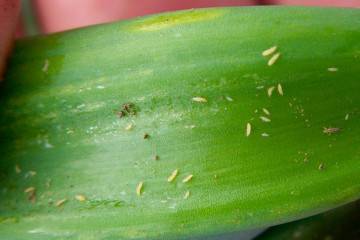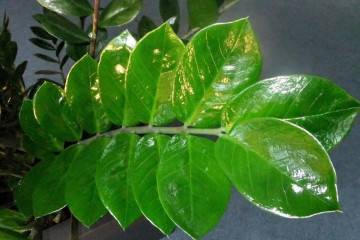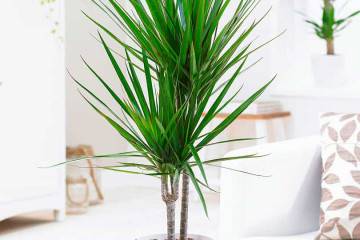Aphids on indoor plants - how to fight at home
Content:
Not a single plant, even if it is indoor, is immune to the appearance of pests. One of the most common insects that growers have to deal with is aphid. It is a small green beetle that feeds on plant sap and leaves behind a sticky coating.
Aphids on indoor plants - how to fight at home
Aphids on plants are usually easy to spot. Insects form large populations and, as a rule, congregate in small groups in different parts of the plant.
Signs of plant damage by aphids
Aphids on foliage are not so difficult to notice if you regularly inspect indoor flowers. Signs of aphids:
- The plant loses its attractive appearance.
- On the foliage, you can see small dots that aphids leave in the course of their life.
- A sticky bloom appears on the surface of foliage and stems.
- The buds are formed small and deformed, constantly flying around.
- Ants can be seen near a plant infected with aphids.
Aphids are usually found on the lower part of the leaf plate and in secluded places between leaves and stems. Usually, the insects gather in large groups, so it is difficult not to notice them.
When aphids appear, the first thing that suffers is the top with young leaves. Leaves curl due to the fact that pests suck out all the juices from them. Then the foliage falls off. In the process of life, aphids leave a white and sticky coating on the foliage. This is also a telltale sign that the pest is already heavily bred.
Due to the fact that the insect sucks out all the juices from the plant, it loses its decorative effect and looks very bad. The leaves curl and fall off, and the buds are deformed and do not bloom.
Where do aphids come from on indoor plants
Aphids can enter a home in a variety of ways. For example, a female can fly in through open windows and lay eggs on indoor flowers. Also, the pest can enter the house with the help of animal hair. Even a person brings insects on his clothes into the house. The insect can be on purchased flowers or bouquets, in the ground used for planting. This happens especially often if the soil was taken from the site.
Aphid remedies on indoor plants
Chemicals should be used if traditional methods are ineffective. Among the variety of fungicides, there are both aggressive and toxic preparations, as well as gentle agents. When etching in the house, it is better to use low-toxic agents. For example, “Preparation 30 Plus” oil, harmless to humans and plants, is suitable.
Effective drugs against aphids:
- Decis;
- Spark;
- Fitoverm;
- Actellik;
- Karate;
- Inta-Vir;
- Neoron.
To increase the effectiveness of drugs, treatments are carried out in a warm room at a temperature of +24 degrees. If the room is cool, the effect will not be as strong.
Folk remedies for aphids on indoor plants
Folk recipes are also effective for the destruction of aphids. Especially if the aphid population is still small.
How to get rid of aphids on indoor flowers at home:
- The simplest and most effective way to kill a pest is a soap solution. To prepare it, you will need warm water and grated laundry soap. It is necessary to dilute the soap in water to get a homogeneous solution. You can also add wood ash to it. The resulting solution is sprayed with indoor plants until all the aphids die.
- Another remedy is garlic infusion. To prepare it, you need to take several large heads of garlic and grate them. Then pour the pulp with water and put in a cool place for 2 days. After the liquid is infused, it must be filtered. Now you can start processing indoor flowers.
- You can get rid of the population with citrus broth. You need to take 100 grams of lemon or orange peels and pour a little water. Remove the infusion in a dark place and leave for several days. Spray the foliage of diseased plants.
- Hot peppers will help to quickly remove the insect. Dissolve 55 g of hot pepper in 100 ml of water. Boil the broth over low heat for 1 hour. Then the broth must be filtered and left to infuse for a day. Before carrying out the procedure, dilute 50 ml in warm water and sprinkle all indoor flowers.
How to get rid of aphids on indoor plants
The appearance of aphids on indoor plants is quite common. If pests on flowers are not noticed in time, the plant will die.
Aphids on a home rose - how to fight
The home rose is one of the favorite plants for aphids. If a pest appears on a flower, you need to immediately start doing something to get rid of it. The insects love to suck juice from young shoots and buds. As a result, the rose not only stops blooming, but also stops growing.
Symptoms of rose defeat:
- The leaves acquire a dirty tint, become sticky and covered with a white coating, losing all their shine.
- Yellow spots appear on the surface of the leaf plate.
- Young shoots are deformed.
- The rose stops blooming even if the buds form.
Before starting treatment, you need to find out the reasons why the pest appeared on the rose and immediately eliminate them.
Why does aphid appear on a rose:
- Excessive application of nitrogen-containing fertilizers to the soil.
- Violation of the conditions for keeping the rose.
- Failure to comply with quarantine for new plants (it is impossible to transfer indoor flowers from the street directly to the house, first they need to be treated from pests).
How to save a rose from aphid misfortune:
- Processing with potassium permanganate helps well. Dissolve a small amount of potassium permanganate in warm water and spray the rose bushes. For the complete destruction of pests, several treatments will be required.
- Tobacco powder is another powerful remedy. Processing with tobacco powder takes place in two stages. First, you need to spray the leaves with garlic infusion, a decoction of tomato tops or soapy water, or treat the foliage with chemicals. Then you need to sprinkle the soil in the pot with tobacco powder. For more effect, you can sprinkle the rose bushes themselves.
- Low toxicity drugs can be used. These are Bankol, Aktara, Mospilan, Commander. Chemicals are used in a course according to the instructions on the package. But they have a significant drawback. With frequent use, insects develop immunity to them.
- Bioinsecticides have proven themselves well. Unlike chemicals for this group of funds, aphids do not develop immunity, so you can not worry about the effectiveness. Fitoverm is suitable for processing indoor roses. You can also use Lepidocide or Gaupsin.
When growing indoor plants, it is important not only to treat them in a timely manner, but also to take preventive measures. To prevent pests from appearing on the rose, you need to regularly inspect the plant and put it under a warm shower. Anti-mosquito nets should be hung on the windows.
Black aphid appeared on jasmine - removal methods
Indoor jasmine is another plant that aphids like to feed on. This insect can do the most harm to the flower.
Aphids on jasmine: how to treat:
- From chemicals, you can use the drug Aktara. This agent is classified as a systemic fungicide with a long-lasting effect. Pest protection lasts from 3 to 5 weeks. You can spray and water plants with Aktara. Toxic substances penetrate into the tissues of the flower. Aphids feed on sap and die. These substances do not harm the plant itself.
- Another tool is Confidor. The drug belongs to contact and systemic insecticides. Most of the insects will be destroyed if the jasmine is poured with Confidor under the root.
- All parasites will die right away if you pour Akarin on jasmine.
A simple and effective remedy is ammonia.
Jasmine processing step by step:
- Before processing, all severely damaged parts of the plant are cut off.
- Places of cuts after the removed stems are sprinkled with crushed charcoal.
- Then you can start spraying.
- In 1 liter of warm water, dilute 30 ml of ammonia and spray the solution throughout the bush.
- If at the first attempt it was not possible to destroy the aphids, the procedure should be repeated.
Aphids on an orchid - how to get rid of
Orchid insects can be removed mechanically. It is suitable if there are still few pests.
Aphids on home flowers: how to get rid of it quickly with your own hands:
- You need to prepare a thick soapy solution from laundry soap and warm water. Each leaf and all stems must be thoroughly wiped with a sponge dipped in this solution. You need to wipe it every day until the entire population disappears. By the same principle, sheet plates can be wiped with alcohol.
- You can remove pests with a decoction of tomato tops. Pour 1 kg of chopped tops with water and put on low heat. Boil the liquid for 40 minutes. Then put the broth in a dark place and leave for 2 days. Add some laundry soap before processing. Process until insects disappear.
- Another remedy that can help remove insects is white mustard. Dilute mustard powder in water and leave to infuse for a day. The solution is filtered before treatment. Getting rid of the insect comes after several treatments.
All these products are suitable for the destruction of aphids on cyclamen, chrysanthemum and other plants.
When aphids appear on indoor flowers, you need to urgently begin to destroy it. There are a large number of ways to fight, ranging from folk methods that are harmless to humans and ending with aggressive chemicals.





















